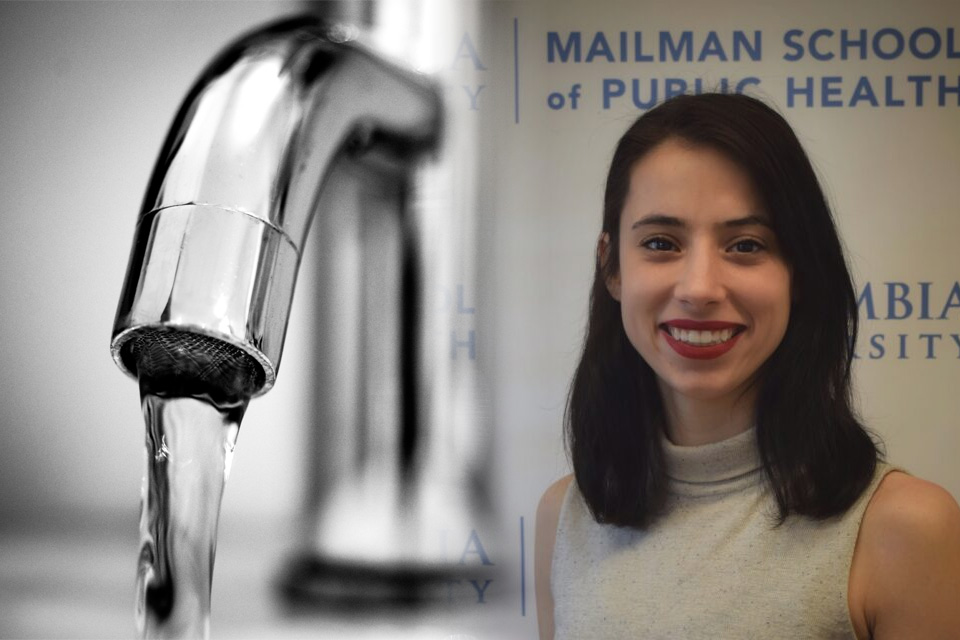Assessing Water Quality to Eliminate Environmental Injustice and Health Disparities
July 26, 2021

Annie Nigra‘s interest in environmental justice is personal. She grew up in a low-income steel mill town outside of Pittsburgh, Pa., where the mill was an important economic engine for the town. When she was a teenager, an environmental study found extreme levels of lead and other metals in the air outside her high school.
Nigra began to see the connections between contaminant locations and the socioeconomic conditions in her home town—how lower income, minority communities were closer to the mill, with likely higher levels of exposure. She began to question why certain communities were more exposed to toxic metals than others, and her passion for environmental justice and helping communities become healthier was born.
Today, Nigra is a postdoctoral research fellow with Columbia University Mailman School of Public Health’s Department of Environmental Health Sciences. She is most invested in and motivated by projects that assess environmental injustices and aim to eliminate exposure and health disparities, particularly when they involve active community engagement.
“I consider my job to be to answer the scientific questions about exposures, impacts, and injustices in order to inform how to move forward for a more just and equitable world,” Nigra said. “This involves considerations of environment, health, and economic well-being.”
Her primary project is an online public drinking water dashboard that maps exposure to a range of contaminants across the U.S. Researchers may assess how various exposures are associated with disease, evaluate how well current regulations work or if modifications may be needed, and compare communities—all insights with powerful implications for regulations and policy. An article about this work on sociodemographic disparities in uranium and other metals in community water systems across the U.S. from 2006-2011 is currently under review.
“There is a water quality crisis in the U.S.,” according to Nigra, who completed her Ph.D. in environmental health sciences at Mailman in 2020. “Most people in the U.S. rely on public water systems, regulated by the EPA, with standards for leading contaminants like arsenic, lead, E. coli, etc. Yet what this research demonstrates is that these EPA regulations do not provide enough protection, and that many communities reliant on public water systems are exposed to contaminants.”
The current dashboard grew out of Nigra’s doctoral research, which involved creating a national map focusing on arsenic exposure in drinking water to inform research into potential connections between arsenic and heart disease. She realized that nationwide estimates of public drinking water arsenic exposures were not readily available, and that there was a need for a large-scale map combining the EPA’s contaminant occurrence data set with community water system data and other demographic information. So, she built it. This research was published by Environmental Health Perspectives in 2020.
The current iteration of the map expands on the initial research and will eventually include 80+ regulated contaminants in a way that will help researchers and advocates from a variety of fields. The team has mapped the inorganics (metals) and radioactive contaminants (including uranium); organics and microbials are next. Nigra also plans to make the map and its science more transparent and accessible. “I want it to be a resource not just for scientists, but also for parents, policymakers, and other community and public health advocates,” she said.
In addition to the enormous project of developing and updating the drinking water map, Nigra is working on two major research projects to examine the relationship between metal exposures (arsenic, mercury, lead, etc.) and chronic disease. One project looks at whether inequalities in metals are associated with inequalities in birth outcomes, with a focus on five to six birth cohorts across the U.S. The second project explores if areas that have reduced arsenic levels show improved outcomes with a geographic focus on California, which has a lot of variability in arsenic exposure levels.
The policy implications of this work are at the heart of Nigra’s motivation. “I ask myself, ‘What are the pieces of scientific evidence that I can contribute to the conversation?’ so that when the EPA reviews regulatory standards, they are making informed decisions to promote environmental equity.”
— Karina Alexanyan, Ph.D.